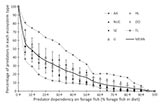The importance of forage fish
by Megan Piechowski, RJD Intern
The intermediate position of forage fish species in the food chain creates a high level of importance of their presence to the health and success of an ecosystem. Forage fish, like herring or anchovies, contribute directly to the commercial fishery economy through their direct catch and contribute indirectly through forage fish predator catch. Therefore Ellen Pikitch, Konstantine Rountos, and a team of researchers sought to quantify the environmental and economical benefit of forage fish and their predators. This information can then be applied to managing the trade-off between fishing and conservational pressures such as how to design more effective management areas and more informed fishing quotas which appropriately balance the predator-prey relationship. Specifically, the team was interested in determining the benefit of forage fish to: the contribution to the production of all forage fish predators, forage fish fisheries (90% of this catch is used for fish meal or fish oil), and to the value of commercially important predator species determined by their dependence on the forage fish for food.
Forage fish are classified as species of fish that feed on small microorganisms and are the primary food source of marine predators including marine mammals, sea birds, fish and squid. The researchers used a set criterion to select a group of Ecopath models that contain data for global estimates of different groups of forage fish and their dependent predators. This information was combined with global catch values (ex-vessel price) to determine the economic impact of the forage fish and forage fish predators. The research group separated the data into three latitudinal regions and seven ecosystem types; which allowed them to compare values and determine patterns (figure 1). Predators were classified by how important forage fish are to their diets – the most extreme classification consisting of a diet 75-100% reliant on forage fish.

Figure 1 from Pikitch et al. 2012. This graph demonstrates the average forage fish contribution to predator production by (a) ecosystem type, and (b) latitude group. It shows that upwelling locations are regions of high forage fish contribution to the ecosystems and it demonstrates the relationship of supported production as the latitudes change. (Ecosystem Key: U = upwelling, TL = tropical lagoon, SE = semi-enclosed, OO = open ocean, NUC = non-upwelling coastal, HL = Arctic high latitude, and AA = Antarctic)
The value of forage fish-supported commercial fisheries was determined to be twice that of forage fish fisheries. The overall contribution of forage fish to the global economy is $16.9 billion dollars. Only $5.6 billion of this is directly from the catch of forage fish while the remaining $11.3 billion is due to the impact forage fish have on commercially important predators. Many predators classified as extremely dependent on forage fish are also listed on the IUCN Red List (which classifies species by their risk of extinction) and are found in upwelling regions (Figure 2). This information suggests that these predators are sensitive to environmental and fishery pressures as they are dependent on a very limited food source. Many implications arise from these results in support of ecosystem-based management, which is a more holistic approach to conservation than the previous species-specific management.

Figure 2 from Pikitch et al. 2012 The percentage of forage fish predators between the ecosystem classifications is compared to their dependence on forage fish at these locations. It demonstrates that, on average, with a very high percentage of predators in each ecosystem there will be a very low dependency on forage fish. This inverse relationship is applicable for all of the seven ecosystems studied. (Ecosystem Key: See Figure 1)
REFERENCES:
Pikitch, E et al. 2012. The global contribution of forage fish to marine fisheries and ecosystems. Fish and Fisheries.




Leave a Reply
Want to join the discussion?Feel free to contribute!